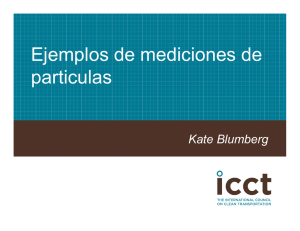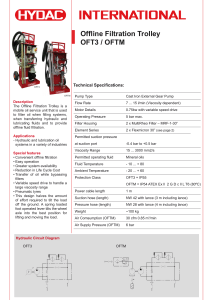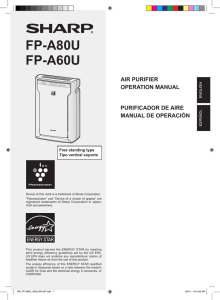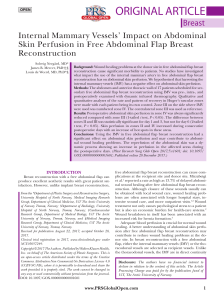Mechanism of clogging by exchange flow of a spinfilter as
Anuncio
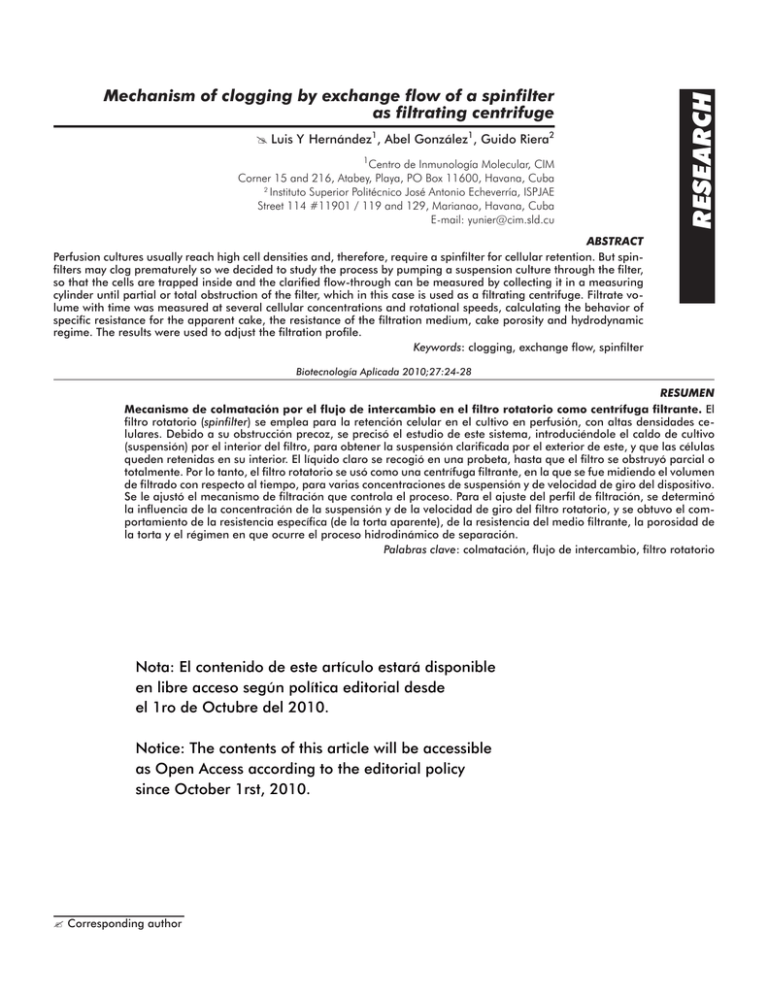
RESEARCH Mechanism of clogging by exchange flow of a spinfilter as filtrating centrifuge Luis Y Hernández1, Abel González1, Guido Riera2 1 Centro de Inmunología Molecular, CIM Corner 15 and 216, Atabey, Playa, PO Box 11600, Havana, Cuba 2 Instituto Superior Politécnico José Antonio Echeverría, ISPJAE Street 114 #11901 / 119 and 129, Marianao, Havana, Cuba E-mail: [email protected] ABSTRACT Perfusion cultures usually reach high cell densities and, therefore, require a spinfilter for cellular retention. But spinfilters may clog prematurely so we decided to study the process by pumping a suspension culture through the filter, so that the cells are trapped inside and the clarified flow-through can be measured by collecting it in a measuring cylinder until partial or total obstruction of the filter, which in this case is used as a filtrating centrifuge. Filtrate volume with time was measured at several cellular concentrations and rotational speeds, calculating the behavior of specific resistance for the apparent cake, the resistance of the filtration medium, cake porosity and hydrodynamic regime. The results were used to adjust the filtration profile. Keywords: clogging, exchange flow, spinfilter Biotecnología Aplicada 2010;27:24-28 RESUMEN Mecanismo de colmatación por el flujo de intercambio en el filtro rotatorio como centrífuga filtrante. El filtro rotatorio (spinfilter) se emplea para la retención celular en el cultivo en perfusión, con altas densidades celulares. Debido a su obstrucción precoz, se precisó el estudio de este sistema, introduciéndole el caldo de cultivo (suspensión) por el interior del filtro, para obtener la suspensión clarificada por el exterior de este, y que las células queden retenidas en su interior. El líquido claro se recogió en una probeta, hasta que el filtro se obstruyó parcial o totalmente. Por lo tanto, el filtro rotatorio se usó como una centrífuga filtrante, en la que se fue midiendo el volumen de filtrado con respecto al tiempo, para varias concentraciones de suspensión y de velocidad de giro del dispositivo. Se le ajustó el mecanismo de filtración que controla el proceso. Para el ajuste del perfil de filtración, se determinó la influencia de la concentración de la suspensión y de la velocidad de giro del filtro rotatorio, y se obtuvo el com­ portamiento de la resistencia específica (de la torta aparente), de la resistencia del medio filtrante, la porosidad de la torta y el régimen en que ocurre el proceso hidrodinámico de separación. Palabras clave: colmatación, flujo de intercambio, filtro rotatorio Introduction This may be determined through experimentation, calThe retention methods most widely applied at the inculating the specific resistance of the cake, the resisdustrial scale are those employed in suspension systance and porosity of the filtration medium and meatems [1], since their scale-up bottlenecks and problems suring the drop in pressure. It is therefore important to are easier and better known [2] than those of other aldetermine the most probable mechanism of clogging ternatives [3]. Perfusion processes in general can be during spinfilter occlusion, so as to better classified depending on the El method used to retain Nota: contenido detheesteoperating artículo estará disponible model this culture regime through research. cells inside the reactor, ranging from the use of exacceso política editorial desde clusion barriers [4,en 5] tolibre vesicles or beads según of a porous Materials and methods material used to entrap the cells within a separate pha1romedium de Octubre 2010. se from that of the el culture [6, 7], or thedel use of Materials a device coupled to the fermentor, such as a spinfilter Filtration system or an external rotary filter [8-14]. The latter method is Notice: Thescaled-up contents of this beisaccessible the only one that can be potentially to cultuThearticle filtrationwill system composed of a mechanical res of hundreds or thousands of liters to obtain dozens stirrer (Alka, Germany) and a spinfilter (B. Braum, as Open Access according to the editorial policy or hundreds of kilograms of the final product [3, 15]. Germany) protected by a glass case. The filter has a In spite of their widespread applicability some2010. opesince October 1rst, cylindrical shape (diameter of 8.5 cm and height of rational aspects of spinfilters remain unstudied. For 26 cm) and is made of stainless steel, with a 10 µm instance, the process of clogging of spinfilters has not pore size mesh of the same material. The spinfilter is been well examined, and the most important variables coupled to the stirrer through a shaft at the upper part affecting it are not known. At the same time, neither of the filter structure [6]. the hydrodynamic regimen under which they operate Volume measurement device (laminar vs. turbulent), nor the relationship between the hydrodynamic process and culture kinetics or the A 2 L measuring cylinder, used as the supporting base compressibility of the apparent cake on the surface of of the spinfilter, is employed to determine volume. the membrane of the device, are sufficiently know. The cylinder collects the cell suspension filtrate from "" Corresponding author 1. Ozturk SS. Engineering challenges in high density cell culture systems. Cytotechnol 1996;22:3-16. 2. Johnson M, Lanthier S, Massie B, Lefevre G, Kamen AA. Use of a Centritech lab centrifuge for perfusion culture of hybridoma cells in protein free medium. Biotechnol Prog 1996;12:855-64. 3. Piret JM, Devens DA, Cooney CL. Nutrients and metabolic gradients in mammalian cell hollow fiber bioreactors Can. J Chem Eng 1991;69:421-8. 4. Fouron Y. Growing cultures in perfusion bioreactors. Nature 1987;327:537-8. 5. Knazek RA, Gullino PM, Kohler PO, Dedrick RL. Cell culture in artificial capillaries: an approach to tissue growth in vitro. Nature 1972;178:65-7. 6. Sinacore MS, Creswick BC, Buehler R. Entrapment and growth of murine hybridoma cells in calcium alginate gel microbeads. Biotechnology 1989;7:1275-9.

